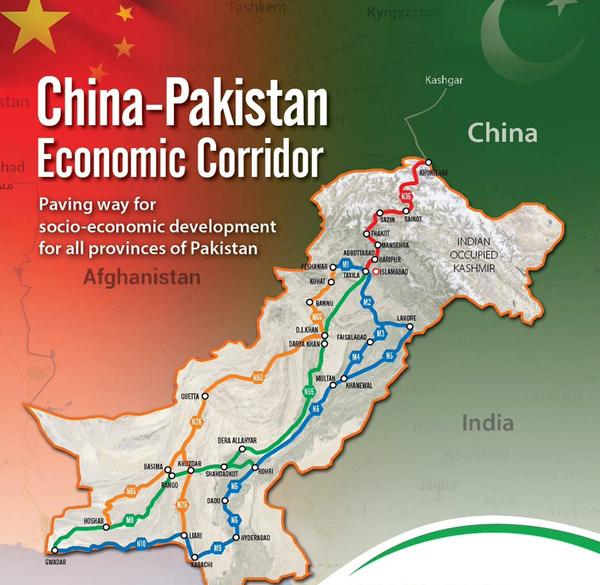 Introduction:
Introduction:
The China-Pakistan Economic Corridor (CPEC) stands as a flagship project of the ambitious Belt and Road Initiative (BRI), envisioned to connect Asia, Africa, and Europe through infrastructure development, trade, and economic cooperation. Launched in 2013, CPEC represents a strategic partnership between China and Pakistan, aiming to catalyze economic growth, alleviate poverty, and foster regional connectivity. This article delves into the multifaceted dimensions of CPEC, exploring its objectives, scope, challenges, and transformative potential for both countries and the broader region.
Origins and Objectives:
CPEC emerged as a strategic collaboration between China and Pakistan, rooted in their shared vision of enhancing bilateral relations and promoting regional integration. At its core, CPEC seeks to address Pakistan's infrastructure deficits, stimulate economic development, and deepen connectivity between the two countries. As part of the broader BRI framework, CPEC aims to create a network of roads, railways, ports, and energy infrastructure spanning from China's western regions to Pakistan's Grader Port, facilitating trade and investment flows along the envisioned Silk Road Economic Belt and the 21st Century Maritime Silk Road.
Scope and Components:
CPEC encompasses a diverse array of projects across multiple sectors, reflecting its comprehensive scope and transformative potential. Key components of CPEC include:
1. Infrastructure Development: CPEC involves the construction of highways, railways, and energy infrastructure to enhance connectivity and facilitate trade between China and Pakistan. Major projects include the Karakorum Highway upgrade, the Lahore-Karachi Freeway, and the Karachi-Peshawar Railway Line.
2. Energy Cooperation: Energy projects constitute a significant portion of CPEC investments, aiming to address Pakistan's chronic energy shortages and power deficits. This includes the development of coal-fired power plants, hydroelectric dams, and renewable energy projects to enhance Pakistan's energy security and sustainability.
3. Grader Port Development: Central to CPEC is the development of Grader Port, located on Pakistan's southwestern coast along the Arabian Sea. As a key maritime hub, Grader has the potential to become a major transshipment point and gateway for trade between China, Pakistan, and other regions, offering strategic access to the Indian Ocean and beyond.
4. Industrial Zones and Special Economic Zones (Sews): CPEC envisages the establishment of industrial zones and sews along the corridor to attract foreign investment, promote industrialization, and create employment opportunities. These zones aim to catalyze economic growth, technology transfer, and export-led development in key sectors such as manufacturing, textiles, and agriculture.
Strategic Significance:
CPEC holds strategic significance for both China and Pakistan, offering a range of geopolitical, economic, and security benefits:
1. Economic Growth and Development: CPEC has the potential to spur economic growth and development in Pakistan by addressing critical infrastructure gaps, stimulating investment, and creating employment opportunities. The infusion of Chinese capital and expertise into key sectors such as transportation, energy, and telecommunications can contribute to poverty alleviation and socio-economic enlistment in Pakistan's underdeveloped regions.
2. Regional Connectivity: As a flagship project of the BRI, CPEC aims to enhance regional connectivity and integration by creating transport corridors linking China, Pakistan, and other countries in South Asia, Central Asia, and beyond. This connectivity can unlock new trade routes, reduce transportation costs, and promote economic cooperation and people-to-people exchanges across borders.
3. Energy Security: CPEC's focus on energy cooperation addresses Pakistan's energy security concerns by diversifying its energy mix and reducing reliance on imported fuels. The development of coal, hydro, and renewable energy projects under CPEC can bolster Pakistan's energy resilience, mitigate power shortages, and support industrial growth and urbanization.
Challenges and Controversies:
Despite its transformative potential, CPEC faces a myriad of challenges and controversies that could impact its implementation and outcomes:
1. Security Risks: CPEC's route traverses volatile regions in Pakistan, including Balochistan and Khyber Pakhtunkhwa, where security concerns such as terrorism, insurgency, and ethnic tensions persist. Security threats pose risks to infrastructure projects and personnel, potentially disrupting construction activities and deterring foreign investors.
2. Debt Sustainability: Critics have raised concerns about the financial sustainability of CPEC projects and their implications for Pakistan's debt burden. The reliance on Chinese loans and investments has led to fears of debt trap diplomacy, wherein Pakistan may become indebted to China and risk sovereignty in the event of default or non-repayment.
3. Socio-Environmental Impacts: The construction of infrastructure projects under CPEC has raised socio-environmental concerns regarding land acquisition, displacement of local communities, and environmental degradation. Mega projects such as dams, highways, and industrial zones may have adverse impacts on ecosystems, water resources, and livelihoods, necessitating robust environmental safeguards and stakeholder consultations.
4. Geopolitical Dynamics: CPEC's strategic implications have sparked geopolitical tensions and rivalries in the region, particularly with neighboring countries such as India and the United States. India, in particular, has raised objections to CPEC's alignment through disputed territories in Pakistan-administered Kashmir, viewing it as a violation of sovereignty and territorial integrity.
Conclusion:
The China-Pakistan Economic Corridor (CPEC) represents a transformative initiative with the potential to reshape the economic landscape of Pakistan and the broader region. By fostering infrastructure development, energy cooperation, and regional connectivity, CPEC aims to catalyze economic growth, alleviate poverty, and enhance strategic partnerships between China and Pakistan. However, the success of CPEC hinges on addressing challenges such as security risks, debt sustainability, and socio-environmental impacts, while navigating geopolitical complexities and fostering inclusive and sustainable development. With concerted efforts and strategic foresight, CPEC has the potential to unlock new opportunities and forge a path towards shared prosperity and stability in South Asia and beyond.



You must be logged in to post a comment.